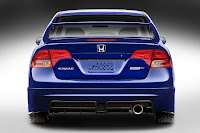 A factory-prepared 2008 Honda Civic MUGEN Si Sedan will debut in mid-October, American Honda Motor Co., Inc., announced today.
A factory-prepared 2008 Honda Civic MUGEN Si Sedan will debut in mid-October, American Honda Motor Co., Inc., announced today.The Civic MUGEN Si Sedan is equipped with a high-performance suspension, forged aluminum wheels, aerodynamic body styling and a sport-tuned exhaust system.
 “Honda enthusiasts have long been asking for factory-installed MUGEN performance products similar to what the company offers in Japan,” said John Mendel, executive vice president of American Honda. “We’re enthusiasts, too, and the ultra-premium Civic MUGEN Si Sedan offers exclusive style and elevated handling performance with legendary Honda refinement.”
“Honda enthusiasts have long been asking for factory-installed MUGEN performance products similar to what the company offers in Japan,” said John Mendel, executive vice president of American Honda. “We’re enthusiasts, too, and the ultra-premium Civic MUGEN Si Sedan offers exclusive style and elevated handling performance with legendary Honda refinement.”The track-tuned suspension, tested at the Twin Ring Motegi racing circuit in Japan, lowers the vehicle by 0.6 inches with aggressive spring and damper tuning for enhanced handling performance while still maintaining a high level of ride comfort. Compared to the conventional Civic Si Sedan, front and rear damping force (both bump and rebound) was increased between 8- and 24-percent. Lightweight 16.98-pound 18×7.5-inch forged aluminum wheels (27 percent lighter than the stock 17×7 alloy wheel) and high-grip BFGoodrich® g-Force KDW 215/40ZR18 summer tires help to create MUGEN’s unique, rewarding and well-balanced handling performance character. The full-vehicle aero-package adds a front spoiler with a sports grille, side spoilers, a rear bumper diffuser and a rear wing.
 The sport exhaust system reduces back pressure from the catalytic converter back. The Civic MUGEN Si Sedan will be available exclusively in Fiji Blue Pearl and include front and rear MUGEN emblems. Inside, a MUGEN Limited Edition placard is located on the center console along with a spherical 50 mm MUGEN aluminum shift knob.
The sport exhaust system reduces back pressure from the catalytic converter back. The Civic MUGEN Si Sedan will be available exclusively in Fiji Blue Pearl and include front and rear MUGEN emblems. Inside, a MUGEN Limited Edition placard is located on the center console along with a spherical 50 mm MUGEN aluminum shift knob.The name MUGEN symbolizes Honda performance throughout Asia and around the globe. MUGEN, under license by M-TEC Co., Ltd., of Japan, has been closely associated with Honda for more than three decades in the design and manufacture of racing and premium aftermarket performance products.
The limited-production vehicle (maximum of 1,000 units for the 2008 model year) will have a retail price of less than $30,000 when it goes on sale and include a full factory warranty. A prototype of the Honda Civic MUGEN Si was shown at the Specialty Equipment Market Association (SEMA) show in fall 2006.
Civic MUGEN Si Sedan Specs:
* Engine Type = i-VTEC DOHC 4-cylinder engine
* Displacement = 2.0 liters (1998 cc)
* Transmission = 6 Speed MT
* Horsepower = 197 @ 7800 rpm
* Torque (lb.-ft.) = 139 @ 6100 rpm
* Ride Height = 5.3 inches (-0.6 inches from Civic Si Sedan)
* Overall Length = 177.8 inches total (+1.1 inches from Civic Si Sedan)
* Wheels: Forged GP 18×7.5 (pattern 5H-114.3 +48)
* Color: Fiji Blue Pearl










































